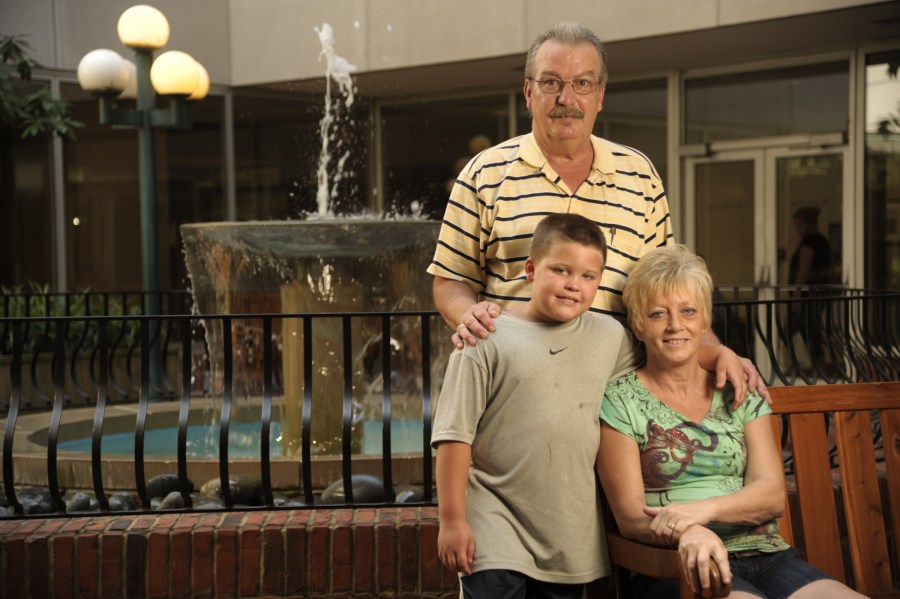
Don Palmer, his wife, Hope, and their grandson, Kaleb Bell, were back at Vanderbilt this week for a follow-up appointment. In July, Don Palmer suffered a heart attack in Medical Center East while waiting for his wife at the Orthopaedic clinic. (photo by John Russell)
Time, and response team, were on his side
Timing really is everything.
If Don Palmer had had his heart attack an hour sooner, he would have been behind the wheel of his car.
A day earlier and he would have been home in Holladay, Tenn., where the nearest hospital is an hour away.
As fate would have it though, he had his heart attack while accompanying his wife to her doctor’s appointment in Medical Center East. He says he was at the right place at the right time.
Palmer’s wife, Hope, was in a car accident on June 24 that broke her ribs and several bones in her legs and feet. Palmer drove her and their 7-year-old grandson, Kaleb Bell, to Vanderbilt for a follow-up appointment on July 20 and dropped them off in front of Medical Center East. He went to park the car.
Kaleb pushed his grandmother’s wheelchair onto the elevator, and they rode together to the fourth floor for Hope’s appointment in the Orthopaedic clinic. Palmer joined them a few minutes later.
He helped her fill out paperwork and escorted her to the exam room. After they met with her doctor, Hope went for an X-ray.
“I felt like I had a little indigestion. I told her I was going to find a water fountain and took a drink and it didn’t help. I came back out and didn’t know where they had taken her for the X-ray. I broke out in a sweat from head to toe and I felt like I had a ton of bricks on my chest,” Palmer recalls.
Palmer keeps nitroglycerine tablets in his pocket since having a stent put in one of his arteries six years ago. He took two tablets.
“When my wife came back out, I said, ‘Don’t panic, but I think I have to go to the ER. I think I’m having a heart attack,’” Palmer recalls.
Hope called for a nurse, who placed him on a table and started oxygen and an IV and called for the Rapid Response Team at 11:53 a.m.
“It seemed like a matter of a minute or two they were all there. It was amazing. They started more IVs and gave me another one of my nitros and headed me to the hospital,” Palmer says.
The Rapid Response Team was implemented five years ago.
The team is supported by ICU nurses from the surgical intensive care unit or medical intensive care unit, a respiratory therapy supervisor and a physician intensivist, when required.
Nurses and family members in the Medical Center are empowered to call 1-1111 to activate the Rapid Response Team at the first sign of a patient decline.
Palmer arrived at the Emergency Department and was joined by Hope and Kaleb, who pushed his grandmother’s wheelchair from Medical Center East to the Emergency Department.
An ECG indicated he was having a heart attack, specifically an ST elevation myocardial infarction (STEMI). He was taken to the cardiac catheterization lab where cardiologists discovered he had 100 percent blockage in his artery. They inserted three stents and transferred him to the cardiovascular intensive care unit.
The time from the call to the Rapid Response Team to the opening of his artery with a tiny balloon was 66 minutes, which, according to Joseph Fredi, M.D., co-director of the STEMI Network, is exceptional.
The American College of Cardiology calls for a door-to-balloon time — the time from when a patient enters the ER to the opening of his artery – of 90 minutes or less.
“We have been able to achieve these incredible times because everyone is functioning as a team. There is a shared responsibility to see how we can care for heart attack patients better,” said Fredi, assistant professor of Medicine.
Time was on Palmer’s side.
“If I had been anywhere else when this happened, I wouldn’t be here today,” Palmer said. “We live 90 miles away, and if it had happened halfway to Nashville, I’d have been a mess.”













